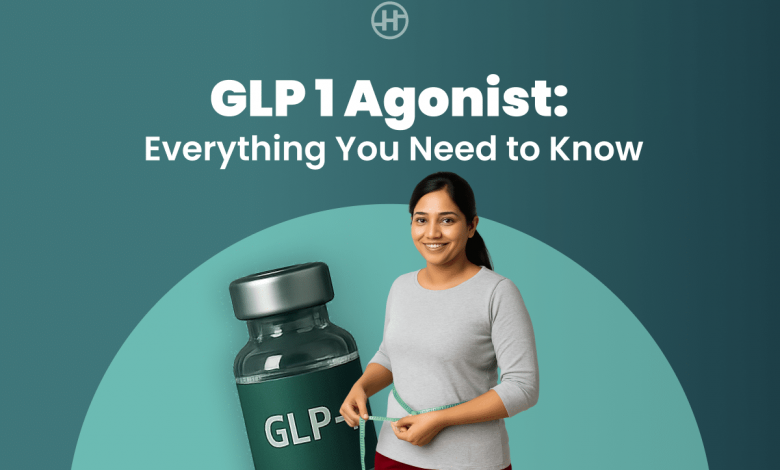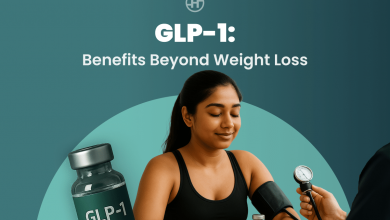GLP-1 Agonist: Essential Guide To Weight Loss & Diabetes

Over the past few years, GLP-1 agonist medications have rapidly gained attention in both medical communities and on social platforms. Once reserved mainly for type 2 diabetes treatment, these drugs are now being discussed as promising tools for weight loss. In India and globally, people are increasingly asking their doctors about “GLP 1,” searching for terms like “GLP 1 weight loss,” “GLP 1 analog,” or even “GLP 1 injection.” But what is it exactly, and why is it suddenly so popular?
There is a lot of noise around GLP-1 receptor agonist drugs, often marketed under brand names like Ozempic, Rybelsus, and Victoza. While the buzz might suggest that these drugs are miracle solutions for obesity, the truth is more complex. These are powerful medications that affect how the body regulates appetite, insulin, and blood sugar. They are effective, but they are also serious prescription drugs that are not for everyone. More importantly, one should not consider taking these medications without understanding their complete mechanism.
So, before joining the trend or brushing it off as hype, it is crucial to understand the science, logic, and limitations behind GLP-1 agonist medications. This article will break down everything you need to know, from their mechanism of action and benefits to risks, side effects, and real-world use cases.
What Does GLP-1 Mean?
GLP-1 stands for Glucagon-Like Peptide-1. It is a naturally occurring hormone produced in the small intestine. GLP-1 plays a key role in blood sugar control by stimulating insulin secretion after meals, slowing down digestion, and promoting a feeling of fullness. Essentially, this hormone tells your body that you have eaten, helps regulate your appetite, and signals your pancreas to release insulin.
The GLP-1 medication in diabetes care is often referred to when explaining how newer antidiabetic drugs work. Because this hormone has multiple metabolic roles, it became the basis for a new class of medications called GLP-1 receptor agonists (GLP-1 RAs) or GLP-1 analogues.
What is a GLP-1 Agonist?
A GLP-1 agonist is a synthetic drug that mimics the effect of the natural GLP-1 hormone in the body. “Agonist” simply means a compound that activates the same receptor as a natural hormone. These medications are designed to bind to the GLP-1 receptors in the body and trigger insulin secretion, reduce glucagon release, and slow gastric emptying. It leads to better blood sugar control and reduced hunger.
Initially developed for people with type 2 diabetes, GLP-1 agonist drugs are now also prescribed for weight loss, especially in individuals with obesity or metabolic syndrome. The newer versions of these drugs can help people lose a significant percentage of body weight when taken with proper supervision.
GLP-1 Agonist Mechanism of Action
Understanding the GLP-1 agonist mechanism of action helps make sense of how it affects both blood sugar and weight. Here is how these medications work:
1. They increase insulin secretion in response to meals
After eating, the body needs more insulin to help glucose from food enter the cells. GLP-1 agonists help the pancreas release insulin only when glucose levels are high. It reduces the risk of sudden blood sugar spikes and lowers the chance of low blood sugar when not needed. Unlike insulin injections, this mechanism works in a more targeted and glucose-dependent manner.
2. They suppress glucagon release
Glucagon is another hormone released by the pancreas. However, it raises blood sugar levels, often when they do not need to rise. GLP-1 agonists reduce the secretion of glucagon, which prevents the liver from producing unnecessary glucose. It helps maintain a better balance and reduces the load on insulin.
3. They slow down gastric emptying
When food moves slowly from the stomach to the small intestine, sugar releases into the bloodstream at a slower pace. That prevents sudden glucose spikes after meals. It also helps people feel fuller for longer, which plays a key role in appetite control and reduces overall food intake.
4. They increase satiety and reduce appetite
GLP-1 agonists act on specific parts of the brain that regulate hunger and fullness. People on these medications tend to feel full more quickly during meals and are less likely to snack between meals. Over time, this helps reduce calorie intake without the person feeling deprived.
Together, these effects result in fewer calories consumed, less glucose production, and improved insulin efficiency. Over time, this contributes to blood sugar control and GLP-1 weight loss benefits.
GLP 1 Agonist Examples
Several GLP-1 receptor agonist drugs are approved globally, including in India. Some are injections, while others are tablets.
Common GLP-1 agonist names include:
- Semaglutide – Ozempic (injection), Rybelsus (tablet)
- Liraglutide – Victoza, Saxenda (injection)
- Dulaglutide – Trulicity (injection)
- Exenatide – Byetta and Bydureon (injection)
- Lixisenatide – Adlyxin (injection)
- Tirzepatide – Mounjaro (technically a dual GLP-1/GIP agonist)
Note that semaglutide and liraglutide are sometimes referred to as GLP-1 analog drugs or GLP-1 tablets in consumer terms.
GLP-1 Agonists for Diabetes and Weight Loss
GLP-1 agonists were first developed and approved for people with type 2 diabetes. The goal was to help manage blood sugar more effectively, especially when first-line treatments like metformin did not produce adequate results. However, as these medications became more widely used, researchers observed something unexpected. Many people were losing weight alongside improved glucose control.
This observation opened new doors. Researchers realized that GLP-1 drugs were not just lowering blood sugar; they were influencing appetite, eating habits, and metabolism. The weight loss was not a side effect. Instead, it was a secondary benefit of the drug’s core mechanisms. Today, certain GLP-1 drugs like semaglutide and liraglutide are available in higher doses specifically for weight management, even in people without diabetes.
In India, where both diabetes and obesity are growing public health concerns, GLP-1 agonists are now being prescribed more widely. In addition to reducing HbA1c levels, they are also supporting long-term weight management in people with a BMI over 27 (with comorbidities) or a BMI above 30. For individuals struggling with conditions like PCOS, metabolic syndrome, or insulin resistance, these drugs can help break the cycle of weight gain and high blood sugar.
However, these medications are never the first step. They are introduced when lifestyle changes alone are not enough, and they are used in combination with a broader health plan that includes dietary adjustments, physical activity, and medical supervision.
The GLP-1 mechanism of action makes them particularly effective for:
- Reducing A1C levels (a 3-month blood sugar average)
- Preventing blood sugar spikes after meals
- Supporting weight loss in overweight individuals
- Reducing appetite and emotional eating
Benefits Beyond Weight Loss and Blood Sugar
While most people talk about GLP-1 agonists in the context of glucose control or weight loss, the benefits of these drugs extend beyond those two areas. Because they target several hormonal and metabolic pathways, their positive effects spread across various health markers.
Here are some notable benefits supported by recent studies:
1. Lowering Blood Pressure
GLP-1 drugs lower blood pressure by promoting weight loss and reducing insulin resistance. It is especially beneficial for people with hypertension, which is a common coexisting condition with obesity or diabetes.
2. Improving Cholesterol and Lipid Levels
These medications may reduce LDL (bad cholesterol) and triglycerides while potentially increasing HDL (good cholesterol). It is partly due to weight loss and partly due to their impact on liver metabolism.
3. Reducing cardiovascular risks
Large-scale studies have shown that some GLP-1 agonists, particularly liraglutide and semaglutide, reduce the risk of major cardiovascular events like heart attacks and strokes. It makes them especially useful for diabetic patients with a history of heart disease or those at high risk.
4. Supporting Kidney Function
GLP-1 drugs may slow the progression of diabetic kidney disease in people with type 2 diabetes. The exact mechanism is still under study, but reduced inflammation, better sugar control, and lower blood pressure all play a role.
5. Reducing Liver Fat
There is early evidence that GLP-1 medications help in reducing fatty liver (NAFLD), which is common among people with obesity and diabetes. Lower liver fat can improve insulin sensitivity and overall metabolic health.
In fact, newer studies are exploring how GLP-1 agonist medications may impact inflammation, gut health, and even cognitive function. However, these findings are still under review.
Are GLP-1 Agonists Safe?
GLP-1 agonists are generally well-tolerated. However, they do come with potential side effects. When starting on these drugs, the most common reactions are gastrointestinal.
Common GLP-1 agonist side effects include:
- Nausea
- Vomiting
- Loss of appetite
- Diarrhea
- Bloating or stomach discomfort
These usually subside within a few weeks as the body adapts. However, there are some rare but serious risks:
- Pancreatitis
- Gallbladder issues
- Thyroid C-cell tumors (observed in animals)
- Allergic reactions
- Low blood sugar, when combined with other medications like insulin
The risk of hypoglycemia is very low when GLP-1 drugs are used alone, but it increases if combined with other antidiabetic drugs. People with a history of thyroid cancer, pancreatitis, or digestive disorders should avoid these drugs unless cleared by a physician.
GLP 1 Agonists: Are They Enough on Their Own?
One crucial question that leads to a lot of misinformation is whether GLP-1 medication alone can make all the difference. GLP-1 drugs work, but they do not replace the need for healthy habits. Just like insulin or metformin cannot reverse diabetes alone, GLP-1 agonists are not magic pills.
Scientific studies show that while people lose more weight with GLP-1 medications than with lifestyle changes alone, the best results come when you combine medication with dietary support, physical activity, and behavior modification.
Here is why they must be used as part of a complete plan:
- Nutrition matters: The appetite suppression will help, but what you eat affects your blood sugar and energy levels.
- Physical activity improves insulin action: Exercise augments glucose uptake and preserves lean mass.
- Support builds consistency: With coaching, people are more likely to stay on track and build long-term habits.
- Sustainability depends on habits: Long‑term success hinges on habit formation without a structured support system, and weight often rebounds once medication is discontinued.
That is where the GLP-1 + Healthify Coach plan makes a meaningful difference. It combines clinically approved medication with the day-to-day support of nutritionists, fitness experts, and doctors who track your progress, adjust plans, and help you avoid common pitfalls. It is medication with mindfulness, structure, and guidance.
HealthifyMe Note
As someone who works closely with people on their weight‑loss journey, I often see how misinformation and shortcuts can derail progress. GLP‑1 drugs are powerful, but they are not shortcuts; they are tools. When used with awareness, planning, and expert supervision, they can bring lasting results. But the real magic lies in consistency: choosing meals wisely, moving your body, and staying accountable.
That is why programs like GLP‑1 + Healthify Coach work. They don’t just offer a prescription; they offer a comprehensive plan, including:
- Personalized meal planning tailored to your tastes, goals, and metabolic needs
- Fitness programming focused on preserving muscle mass and boosting metabolism
- Regular doctor oversight to adjust doses, manage side effects, and ensure safety
- Side‑effect management strategies—like gradual dose titration and dietary tweaks—to keep you comfortable
- Progress and outcome monitoring so you can see real data on weight, A1C, body composition, and more
- Habit‑building support through coaching check‑ins, goal‑setting, and accountability tools
You do not need to go through it alone; you just need to do it right. Programs that combine medication with tailored nutrition, exercise, medical guidance, and behavioral coaching give you the best chance at sustainable, long‑term success.
The Final Word
The rising interest in GLP-1 agonist medications is a lot more than just a trend. It is part of a broader shift in how we understand weight management and metabolic health. These drugs offer hope for people who have struggled with stubborn weight and uncontrolled diabetes. They bring together science, medicine, and the body’s natural processes.
But with great results come great responsibilities. GLP-1 drugs work best when used with expert supervision in the context of your unique health needs. They are not for everyone, and they are not meant to replace diet, exercise, or lifestyle changes.
That is why GLP-1 + Healthify Coach is the best support that works as a journey. A journey where your weight loss is not just about numbers but about health, energy, and a better quality of life. When used wisely, GLP-1 agonists can be the beginning of real, lasting change.
Frequently Asked Questions (FAQs)
Q: What is the GLP-1 full form in diabetes?
A: GLP-1 stands for Glucagon-Like Peptide-1. It is a hormone produced in the intestines that helps regulate blood sugar, insulin, and appetite. GLP-1 agonists are drugs that mimic this hormone to support diabetes management and weight loss.
Q: Are GLP-1 drugs safe to use long-term?
A: GLP-1 agonists are considered safe for long-term use when prescribed by a healthcare provider. Most side effects are mild and temporary, but people with certain health conditions should avoid them. Growing clinical research supports long-term safety.
Q: Do GLP-1 agonists help with weight loss even if you do not have diabetes?
A: Yes, some GLP-1 medications, like high-dose semaglutide and liraglutide, are approved for weight loss in non-diabetics. These drugs help control appetite and reduce calorie intake, making them effective for people with obesity.
Q: Are there GLP-1 tablets available, or are all medications injectable?
A: Yes, GLP-1 medications are available in both injectable and tablet forms. Rybelsus is the oral version of semaglutide and is taken once daily. Most others, like Ozempic or Trulicity, are injectables taken weekly or daily.
Q: What are the most common GLP-1 agonist side effects?
A: The most common side effects include nausea, vomiting, diarrhea, and loss of appetite. These typically occur when starting the drug and decrease over time. Rare but serious side effects include pancreatitis and thyroid issues.
Q: Can GLP-1 drugs be used along with other diabetes medications?
A: Yes, they are often used in combination with other medications like metformin. However, when taken with drugs like insulin or sulfonylureas, there may be a risk of low blood sugar. A doctor should guide these combinations.
Q: Is GLP-1 with Healthify Coach better than taking GLP-1 alone?
A: GLP-1 drugs offer great potential, but using them with structured support, like diet planning, fitness coaching, and expert medical guidance, makes the results stronger and more sustainable. That is the strength of the GLP-1 + Healthify Coach plan.
Research Sources
1. Glucagon-Like Peptide-1 Receptor Agonists
2. American Diabetes Association. What Are My Options for Type 2 Diabetes Medications?
3. GLP-1 Receptor Agonists for the Treatment of Obesity: Role as a Promising Approach.
4. Oral and Injectable (Non-Insulin) Pharmacological Agents for the Treatment of Type 2 Diabetes
5. Medication for type 2 diabetes



